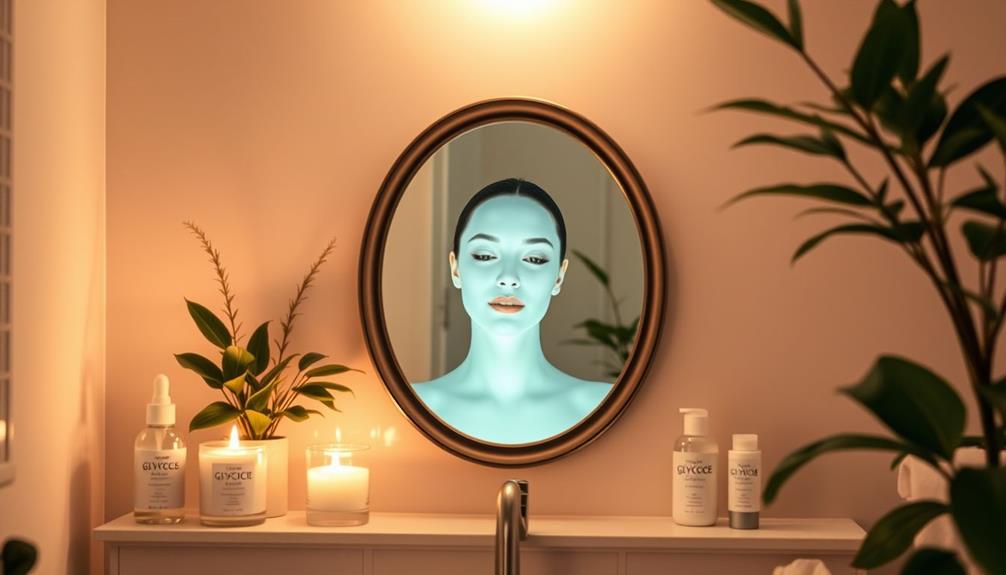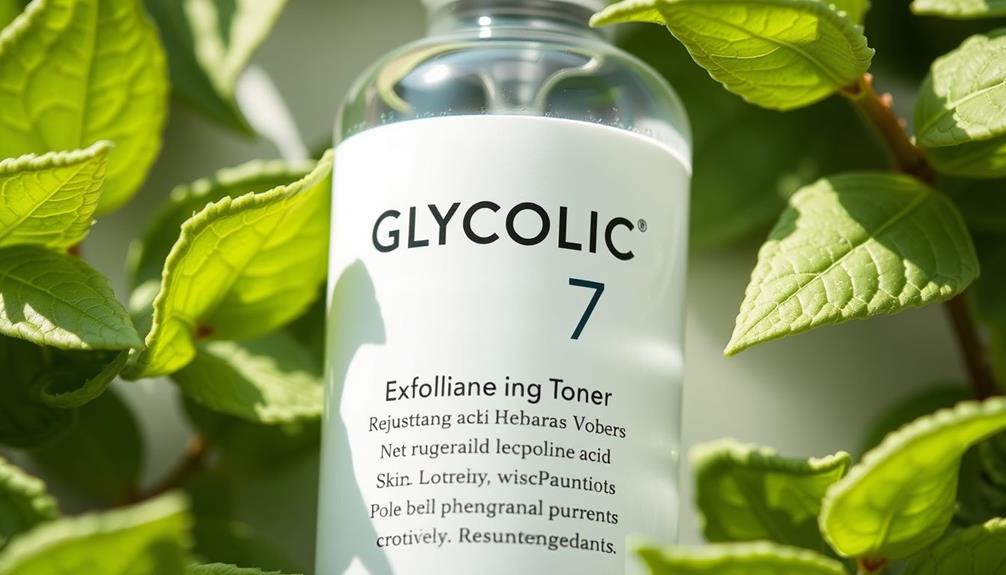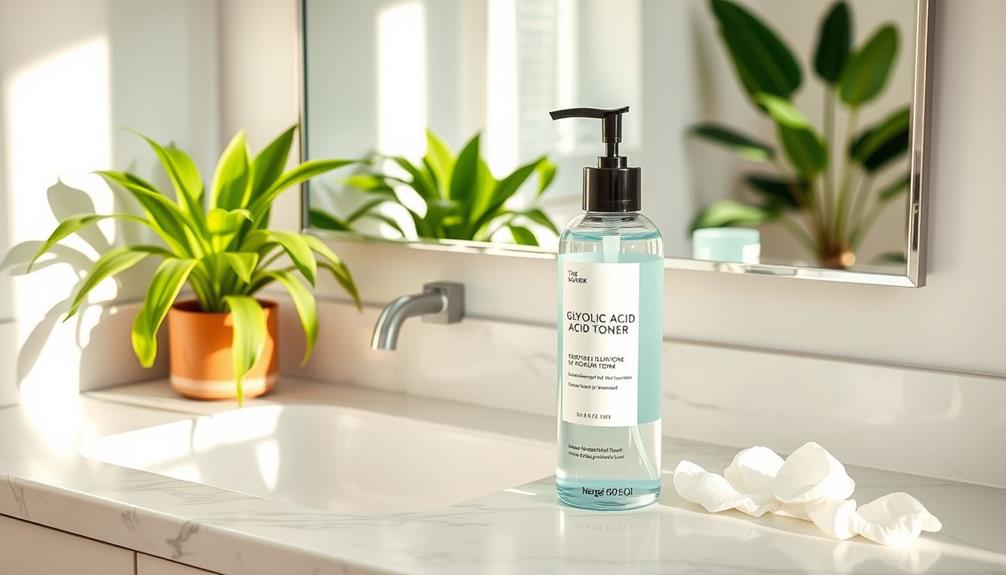Glycolic acid is an effective exfoliant that has the ability to completely transform your skin. It gently eliminates dead skin cells, enhancing texture and resulting in a glowing complexion. By encouraging collagen production, it aids in reducing the appearance of fine lines, wrinkles, and even acne scars. Due to its small molecular size, it is able to deeply penetrate the skin, ensuring optimal absorption of your skincare products. Nonetheless, it may lead to mild redness or peeling, particularly for those with sensitive skin. It is recommended to apply glycolic acid in the evening and apply sunscreen during the daytime. Interested in learning how to select the appropriate products and utilize glycolic acid effectively? Stay tuned for more insights!
Key Takeaways
- Glycolic acid is a potent exfoliant that enhances skin texture and promotes a radiant complexion by removing dead skin cells.
- It effectively reduces acne and blemishes by unclogging pores and accelerating the healing process.
- As a humectant, glycolic acid attracts moisture, improving hydration and helping to retain skin's natural moisture barrier.
- Start with a patch test and apply glycolic acid products in the evening to minimize potential irritation and sun sensitivity.
What Is Glycolic Acid?

Glycolic acid, a powerful alpha-hydroxy acid derived from sugarcane, exfoliates your skin and improves its texture. It's the smallest molecular size among AHAs, which means it penetrates deeper into your skin for more effective results.
By promoting cell turnover, glycolic acid helps slough off dead skin cells, making way for smoother, healthier skin. Regular use of exfoliating acids like glycolic acid can also enhance the effectiveness of other skincare products, similar to how skincare patches deliver concentrated ingredients directly to the skin.
This exfoliating powerhouse is particularly effective in treating issues like acne and hyperpigmentation. By unclogging pores and reducing excess oil, it can help prevent breakouts while fading dark spots left behind.
Additionally, glycolic acid addresses signs of aging, such as fine lines and wrinkles, giving your skin a youthful appearance.
You can find glycolic acid in various skincare products, including serums and cleansers, as well as in professional chemical peels. For at-home use, concentrations typically range from 5% to 10%, while higher concentrations are best reserved for treatments under dermatological supervision.
Incorporating glycolic acid into your skincare routine can lead to significant improvements in your skin's appearance and overall texture.
Benefits for Skin Health

Glycolic acid offers multiple benefits for your skin health, starting with its powerful exfoliation properties that enhance texture and promote a radiant complexion.
By improving skin cell turnover, glycolic acid allows for better absorption of other skincare products, making your routine more efficient.
It can also help reduce acne and blemishes by keeping your pores clear and preventing breakouts.
Plus, its ability to retain moisture guarantees your skin stays hydrated and healthy.
effective in addressing anxiety and stress-related issues, which can also reflect positively on your skin.
Exfoliation and Texture Improvement
Exfoliation with glycolic acid reveals a smoother, more radiant complexion by effectively dissolving the bonds between dead skin cells. As a powerful alpha-hydroxy acid (AHA), glycolic acid penetrates deeper layers of your skin, enhancing skin texture and tone.
By incorporating glycolic acid into your routine, you can accelerate cell turnover, which helps minimize the appearance of fine lines and wrinkles, giving you a more youthful look.
Additionally, using essential oils like Lavender and Chamomile can complement your skincare routine by promoting relaxation and reducing stress, further enhancing your skin's overall health and appearance through aromatherapy benefits.
Regular use of glycolic acid not only improves skin texture but also enhances hydration. It boosts moisture retention, contributing to plumper, healthier skin. This increased hydration can make your skin feel softer and more supple, further enhancing its overall appearance.
Moreover, glycolic acid can help unclog pores, leading to a clearer complexion. While this also aids in reducing acne outbreaks, the main benefit here is the smoother texture and even tone you'll enjoy.
Acne and Blemish Reduction
For those struggling with acne and blemishes, incorporating glycolic acid into your skincare routine can greatly improve your skin health by effectively exfoliating dead skin cells and unclogging pores. This powerful ingredient helps to prevent the formation of new breakouts by sloughing away debris that can lead to clogged pores.
Studies have shown that a 5% glycolic acid complex can considerably improve mild to moderate acne vulgaris, making it a go-to choice for many. Additionally, integrating essential oils for skin health can provide antimicrobial benefits that support overall skin clarity and balance.
Glycolic acid promotes cell turnover, accelerating the healing of existing blemishes and helping to fade post-inflammatory hyperpigmentation, which leads to a more even skin tone. Its ability to penetrate deeply into the skin stimulates collagen production, improving overall skin texture and reducing the appearance of acne scars over time.
Regular use of glycolic acid not only targets current issues but also enhances the effectiveness of other acne treatments by improving the absorption of topical products applied afterward. By prioritizing glycolic acid in your regimen, you can take considerable steps toward clearer, healthier skin.
Hydration and Moisture Retention
Boosting hydration and moisture retention, glycolic acid effectively enhances your skin's overall health and appearance. This powerhouse ingredient acts as a humectant, attracting and binding water to your skin, which markedly improves hydration levels and elasticity.
By promoting cell turnover, glycolic acid helps shed dry, dead skin cells, allowing better moisture absorption in deeper layers. Incorporating gentle yoga stretches before bedtime can also help your skin rejuvenate overnight, contributing to overall wellness and hydration yoga for back pain relief.
Regular use of glycolic acid leads to a more hydrated complexion by improving your skin's natural barrier function, which reduces trans-epidermal water loss. Studies show that it can even increase skin hydration by enhancing the synthesis of hyaluronic acid, a key molecule that retains moisture in your skin.
Incorporating glycolic acid into your skincare routine can also alleviate dry patches and flakiness, resulting in a smoother, more radiant texture. You'll notice that your skin feels not only healthier but also looks more vibrant and youthful.
How Glycolic Acid Works

Glycolic acid works by breaking down the bonds between dead skin cells, making it easier for them to be exfoliated away. This process not only reveals fresh skin but also enhances the absorption of other skincare products you might use.
Incorporating a holistic lifestyle approach, such as balanced nutrition and regular exercise, can further improve your skin's health and appearance by supporting overall wellness.
As a result, you can enjoy smoother, healthier skin with improved elasticity and a youthful glow, especially when combined with mindful eating habits.
Exfoliation Mechanism Explained
As the smallest alpha-hydroxy acid, glycolic acid penetrates the skin effectively, breaking down the bonds between dead skin cells to promote exfoliation. This powerful exfoliation mechanism works wonders on the outermost layer of skin, accelerating cell turnover and revealing smoother, more radiant skin beneath.
Here's how it benefits your skin:
- Removes Dead Skin Cells: Glycolic acid dissolves the bonds that hold dead skin cells together, making it easier for your skin to shed them.
- Improves Skin Texture: By promoting exfoliation, it refines skin texture, helping to treat uneven skin tone and improve overall appearance.
- Stimulates Collagen Production: In the deeper layers of skin, glycolic acid boosts collagen production, enhancing firmness and reducing fine lines and wrinkles.
- Addresses Skin Conditions: It's effective in treating various skin conditions, including acne, by unclogging pores and reducing hyperpigmentation.
Additionally, glycolic acid's humectant properties attract moisture, improving hydration levels and ensuring your skin feels fresh and plump.
Incorporating glycolic acid into your routine can greatly enhance your skin's health and appearance.
Benefits for Skin Health
Harnessing its powerful exfoliating properties, glycolic acid effectively improves skin health by promoting a smoother, more radiant complexion. This potent alpha-hydroxy acid (AHA) exfoliates the skin by dissolving the bonds between dead skin cells, revealing the fresh skin underneath. As you incorporate glycolic acid into your routine, you'll notice enhanced skin texture and hydration levels.
Additionally, glycolic acid stimulates collagen production, which boosts skin elasticity and firmness. This helps in reducing the appearance of fine lines and wrinkles, making it a great anti-aging option. If you struggle with hyperpigmentation or dark spots, glycolic acid can also help fade these imperfections, leading to a more even skin tone over time.
Moreover, glycolic acid effectively addresses acne concerns by penetrating deeper layers of the skin and preventing clogged pores. With regular use, you'll experience a rejuvenated and youthful appearance while enjoying the benefits of improved skin health.
Ultimately, incorporating glycolic acid into your skincare routine can transform your skin, offering a clearer, smoother, and overall healthier complexion.
Recommended Application Methods

When incorporating glycolic acid into your skincare routine, start gradually to allow your skin to adjust. Here are some recommended application methods to guarantee you get the best results while minimizing skin sensitivity:
- Patch Testing: Before applying glycolic acid to your entire face, conduct a patch test on a small area to check for any adverse reactions.
- Evening Application: Apply glycolic acid products in the evening to reduce the risk of sun sensitivity. This timing helps your skin recover overnight.
- Follow Product Instructions: Always adhere to the product instructions regarding application frequency and amount. Start with a 5-10% concentration, using it 1-2 times weekly.
- Hydrating Serum: After applying glycolic acid, consider using a hydrating serum or moisturizer to combat dryness and irritation, enhancing your skin's overall texture.
Lastly, don't forget to use a broad-spectrum sunscreen during the day, as exfoliation can make your skin more vulnerable to UV damage. By following these steps, you'll guarantee a smoother shift into incorporating glycolic acid into your skincare routine.
Potential Side Effects

Glycolic acid can cause side effects like redness, tingling, and peeling, particularly at the start of treatment or with higher concentrations. If you have sensitive skin, you might experience heightened irritation, so patch testing is a smart move before diving in. Overusing glycolic acid or opting for high concentrations can lead to severe irritation, chemical burns, and worsen conditions like eczema or rosacea.
Keep in mind that increased sun sensitivity is a significant concern. You'll need to apply broad-spectrum sunscreen daily to protect your skin from UV damage.
Here's a quick overview of potential side effects:
| Side Effect | Description |
|---|---|
| Redness | Skin may appear flushed or irritated. |
| Tingling | A prickling sensation upon application. |
| Peeling | Skin may shed dead cells more rapidly. |
| Irritation | Increased discomfort, especially for sensitive skin. |
If you're unsure about using glycolic acid, it's best to consult a dermatologist for personalized recommendations, especially if you have existing skin conditions. Taking these precautions can help you enjoy the benefits while minimizing side effects.
Choosing the Right Products

Selecting the right glycolic acid products can make a significant difference in achieving your desired skincare results. To help you navigate your options, keep these key factors in mind:
- Concentration of Glycolic Acid: Look for over-the-counter options with a concentration between 5% to 10%. This range is generally safe for most skin types, especially when you're just starting out.
- pH Level: Opt for formulations with a pH level between 3 to 4. This range allows glycolic acid to work effectively while maintaining your skin's health.
- Hydrating Ingredients: Choose products that include hydrating ingredients like hyaluronic acid or glycerin. These can help counteract dryness and irritation often caused by glycolic acid.
- Ingredient Labels: Always read ingredient labels to avoid products that combine glycolic acid with other strong exfoliants, such as retinoids or other AHAs. This can help minimize the risk of irritation and guarantee your skin stays healthy.
Frequently Asked Questions
What Do I Need to Know Before Taking Glycolic Acid?
Before taking glycolic acid, you need to know about potential irritation, the importance of patch testing, and starting with lower concentrations. Always use sunscreen daily, as it can increase your skin's sensitivity to the sun.
What to Avoid When Using Glycolic Acid?
Imagine a delicate flower under harsh sunlight. When using glycolic acid, avoid mixing it with other strong exfoliants, applying on irritated skin, skipping sunscreen, exceeding use frequency, or using high concentrations without guidance to protect your skin's health.
What Does Glycolic Acid Do to Your Skin?
Glycolic acid exfoliates your skin, dissolving dead cell bonds for a smoother texture. It boosts collagen, improves hydration, fades dark spots, and helps reduce acne by unclogging pores, leaving you with a fresher, healthier complexion.
How Do You Get the Best Results From Glycolic Acid?
To get the best results from glycolic acid, start with a low concentration, use it at night, incorporate hydrating ingredients, and patch test. Gradually increase usage while avoiding other strong actives to prevent irritation.
Conclusion
Incorporating glycolic acid into your skincare routine is like planting a garden; with the right care and attention, your skin will flourish.
Just as flowers bloom with the right nutrients, glycolic acid helps reveal a brighter, smoother complexion by exfoliating dead skin cells.
Remember to start slow and listen to your skin's needs, and soon you'll see the vibrant results you've been waiting for.
Embrace this powerful ingredient, and watch your skin transform into a radiant masterpiece.










